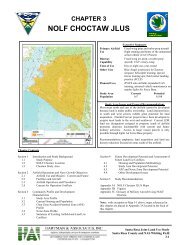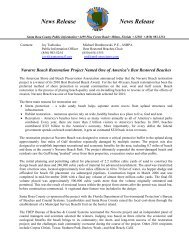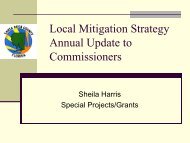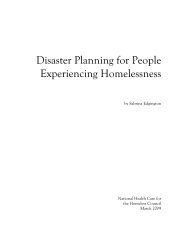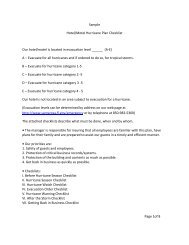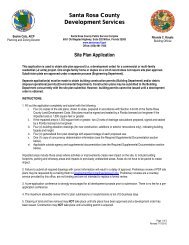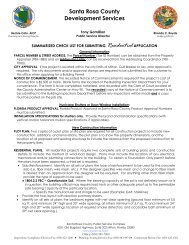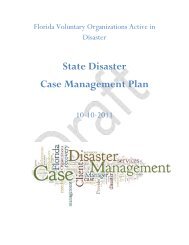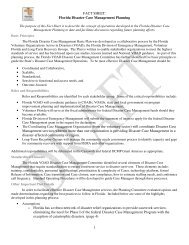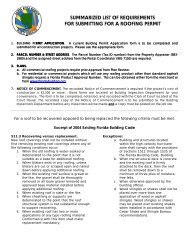Disaster - Santa Rosa County
Disaster - Santa Rosa County
Disaster - Santa Rosa County
Create successful ePaper yourself
Turn your PDF publications into a flip-book with our unique Google optimized e-Paper software.
Turning Off Utilities<br />
18<br />
Wind Storm Downs Tree in Milton<br />
Your Trees & the Next Storm<br />
Are you and your trees safe from the possible wrath of<br />
Mother Nature Thousands of trees and communities<br />
are damaged annually by heavy winds and rains. But<br />
yours can be spared from the worst damage by following<br />
a few practical suggestions from the International<br />
Society of Arboriculture.<br />
Pre-Storm Tree Preparation<br />
Look for potential hazards: Investigate<br />
the condition of your trees. You or a certified arborist<br />
should look for damage such as cracks in the trunk or<br />
major limbs, hollow, aged, and decayed trees; hanging<br />
branches; improperly formed branches, one-sided<br />
or significantly leaning trees, and branches that may<br />
potentially rub the house.<br />
Know your tree species: Some species are<br />
more prone to storm damage. Some of the more<br />
common trees include: older laurel oak, queen palm,<br />
jacaranda, Poinciana, Australian pine, slash pine,<br />
silk oak, peltophorum, melaleuca, orchid, chinaberry,<br />
gumbo limbo, bischofia, tamarind, acacia, tabebuia,<br />
cassia, rosewood, Chinese tallow, ficus, mimosa,<br />
avocado, and Chinese elm trees.<br />
Do not top your trees: Untrained individuals<br />
may urge you to cut back all of the branches on the<br />
mistaken assumption that it will help avoid breakage<br />
in future storms. However, professional arborists say<br />
that “topping,” the cutting of main branches back to<br />
stubs, is extremely harmful and unhealthy for your<br />
trees. Stubs will often grow back many weakly attached<br />
branches that are higher and are more likely to break<br />
when a storm strikes. Also, topping will reduce the<br />
amount of foliage, on which the tree depends for the<br />
food and nourishment needed for re-growth. A topped<br />
tree that has already sustained major storm damage is<br />
more likely to die than repair itself.<br />
Water, gas and electric utilities produce a constant<br />
supply to your home and if there is a failure in a<br />
pipe, valve, circuit, equipment or an appliance, then<br />
uninterrupted flow of any utility source can pose,<br />
at a minimum, serious damage to your home and at<br />
worst lethal consequences. In case of an emergency<br />
all responsible adults in the home should know<br />
where and how to operate the main shutoffs. It is<br />
also important the area around each utility shutoff is<br />
kept clear of obstructions like furniture and storage<br />
items or, in the case of an outside shut off, make<br />
sure plants have not over grown the area.<br />
Turning Off Natural Gas<br />
• Because there are different gas shut-off procedures<br />
for different gas meter configurations, it is important<br />
to contact your local gas company for guidance on<br />
preparation and response regarding gas appliances<br />
and gas service to your home.<br />
• Be sure not to actually turn off the gas when<br />
practicing the proper gas shut-off procedure.<br />
• If you smell gas or hear a blowing or hissing noise,<br />
open a window and get everyone out quickly. Turn<br />
off the gas, using the outside main valve if you can,<br />
and call the gas company from a neighbor’s home.<br />
• CAUTION: If you turn off the gas for any reason,<br />
a qualified professional must turn it back on. NEVER<br />
attempt to turn the gas back on yourself.<br />
Turning Off Water<br />
You will need to protect the water sources already in<br />
your home from contamination if you hear reports of<br />
broken water or sewage lines, or if local officials advise<br />
you of a problem.<br />
• To close the incoming water source, locate the<br />
incoming valve and turn it to the closed position. To<br />
use the water in your pipes, let air into the plumbing<br />
by turning on the faucet in your home at the highest<br />
level. A small amount of water will trickle out. Then<br />
obtain water from the lowest faucet in the home.<br />
• To use the water in your hot-water tank, be sure the<br />
electricity or gas is off, and open the drain at the<br />
bottom of the tank. Start the water flowing by turning<br />
off the water intake valve at the tank and turning on<br />
the hot water faucet. Refill the tank before turning the<br />
gas or electricity back on. If the gas is turned off, a<br />
professional will be needed to turn it back on.<br />
Turning Off Electricity<br />
• Locate your electricity circuit box.<br />
• Flip the breaker fully to the off position.<br />
• FOR YOUR SAFETY: Always shut off all the<br />
individual circuits before shutting off the main circuit<br />
breaker.<br />
Preventing Damage




